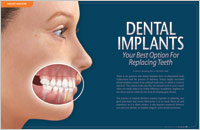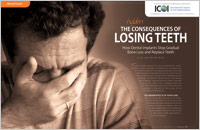Dental Implants in Fox Chapel
Advanced, Full-Scope Implant Dentistry – All in One Office
At Fox Chapel Advanced Dental Care, we offer comprehensive dental implant solutions — from simple to complex cases — all under one roof. Whether you're missing one tooth or need a full-mouth restoration, we have the experience, technology, and in-house capabilities to rebuild your smile with precision and care.
Why Choose Us for Dental Implants?
We’re not just placing implants — we’re transforming lives. Our advanced office is fully equipped with state-of-the-art technology and an on-site dental lab, allowing us to plan, place, and restore implants with unmatched accuracy and efficiency.
Our Dental Implant Services Include:
-
Tooth Extractions – Gentle removal when necessary to prepare for implant placement.
-
Bone Grafting – Restore and strengthen bone for optimal implant support.
-
Single and Multiple Dental Implants – Replace missing teeth with natural-looking, long-lasting solutions.
-
Full-Arch Restoration (All-on-X) – Get a stable, fixed smile without traditional dentures.
-
3D Imaging & Digital Planning – We use advanced CBCT scans and guided surgery to enhance safety and precision.
-
Same-Day Restorations – Thanks to our in-house lab and CEREC technology, many patients leave with teeth the same day.
A Seamless, Spa-Like Experience
From the moment you arrive, you'll notice a difference. Our spa-like environment, personalized approach, and modern technology ensure your comfort throughout every phase of treatment.
Restore Your Confidence
Dental implants are the gold standard for tooth replacement — durable, natural-looking, and designed to last for decades. Whether you’re replacing a single tooth or rebuilding your entire bite, we’re here to help you smile again with confidence.
Related Dental Implant Articles

Dental Implants – Your Third Set of Teeth
A discovery fifty years ago paved the way for one of dentistry's most exciting, natural looking and successful tooth replacement systems. Learn how dental implants might just possibly change your life... Read Article

The Hidden Consequences of Losing Teeth
For those missing even one tooth, an unsightly gap is actually the least significant problem. What's of far greater concern is the bone loss that inevitably follows tooth loss. Dental implants fused to the jawbone can preserve bone, improve function and enhance psychological well-being. Learn how implants serve both as anchors to support replacement teeth, and preserve bone as one of the better preventive maintenance procedures in dentistry... Read Article
 Dental Implants - Evaluating Your Options for Replacing Missing Teeth
Dental Implants - Evaluating Your Options for Replacing Missing Teeth
As we guide you through the marketing hype you'll see that well planned implants most often require a team approach in assessing whether they're right for you. Not only are they a better treatment choice, they will last longer, possibly a lifetime, making them the right choice and the most cost effective option long term... Read Article
 Implant Overdentures for the Lower Jaw
Implant Overdentures for the Lower Jaw
Implant overdentures represent a major change for the dental profession and the public. The lower jaw two-implant overdenture may be considered a more appropriate starting point over regular dentures... Read Article
SINGLE TOOTH MISSING
Benefits of an all-ceramic crown on implant:
When both the tooth and root are damaged, the best permanent replacement is a dental implant in conjunction with a ceramic crown. This solution both looks and functions just like a natural tooth.
In this case, a so-called one-piece implant is used. This means that all components are installed as a single unit, resulting in immediately full functioning teeth, shorter treatment time and minimized pain.
- Immediately functioning teeth
- Excellent esthetic result
- Life long, stable solution
Treatment:
This procedure normally includes four visits to the dentist. You should expect to be able to work the day after having the implant installed.
COURSE OF TREATMENT
INSTALLING THE NEW TOOTH – STEP-BY-STEP
The course of treatment described here is one of several options available. Consult your dentist to find out what the best solution is for you, given your specific condition.
 |  |
1: Before the procedure
The dentist makes a first examination and takes one or more x-rays of the area to prepare for the procedure. | 2: Installing the implant
The implant is installed. At this time, a temporary tooth is provided that allows you eat and function like normal almost immediately. The implant will need a few months to integrate with the jawbone before the next step is taken. |
 |  |
3: Attaching the new crown
The final step is the placement of the permanent ceramic tooth. The new tooth is installed for life. No additional treatment is needed. | 4: End result
You should expect the new tooth to fit and function just like a natural tooth. Do your usual dental hygiene to keep the tooth and gum around it clean and |
ALTERNATIVES TO AN ALL-CERAMIC CROWN ON IMPLANT
 | Tooth-supported fixed bridge
A traditional bridge involves grinding down adjacent teeth to support the bridge. It is a stable solution with good esthetics and function that is fairly easy to install. However, this alternative has two main disadvantages: continuous bone resorbtion in the edentulous area, and sacrificing healthy teeth on behalf of the bridge. |
 | Removable partial denture
This is not a permanent alternative to a lost tooth. It is unstable and loosely attached, which affects both function and comfort. A removable partial denture is made of plastic – a material that can't create the same esthetic result as a ceramic crown. The benefits are few but do exist: adjacent teeth aren't affected. It is easily and quickly installed and relatively cheap. |
 | Maryland bridge
This alternative has some clear advantages: it is quickly installed, functions well and, since it is made of ceramic, it gives a high esthetic result. Moreover, natural healthy teeth aren't affected. But it is not very permanent. The resin-bonded bridge will eventually come off – probably after just a couple of years – and will then have to be reinstalled. |
Related Dental Implant Articles
 Dental Implants – Your Third Set of Teeth
Dental Implants – Your Third Set of Teeth
A discovery fifty years ago paved the way for one of dentistry's most exciting, natural looking and successful tooth replacement systems. Learn how dental implants might just possibly change your life... Read Article
 The Hidden Consequences of Losing Teeth
The Hidden Consequences of Losing Teeth
For those missing even one tooth, an unsightly gap is actually the least significant problem. What's of far greater concern is the bone loss that inevitably follows tooth loss. Dental implants fused to the jawbone can preserve bone, improve function and enhance psychological well-being. Learn how implants serve both as anchors to support replacement teeth, and preserve bone as one of the better preventive maintenance procedures in dentistry... Read Article
 Dental Implants - Evaluating Your Options for Replacing Missing Teeth
Dental Implants - Evaluating Your Options for Replacing Missing Teeth
As we guide you through the marketing hype you'll see that well planned implants most often require a team approach in assessing whether they're right for you. Not only are they a better treatment choice, they will last longer, possibly a lifetime, making them the right choice and the most cost effective option long term... Read Article
 Implant Overdentures for the Lower Jaw
Implant Overdentures for the Lower Jaw
Implant overdentures represent a major change for the dental profession and the public. The lower jaw two-implant overdenture may be considered a more appropriate starting point over regular dentures... Read Article
SINGLE TOOTH MISSING
Benefits of an all-ceramic crown on implant:
When both the tooth and root are damaged, the best permanent replacement is a dental implant in conjunction with a ceramic crown. This solution both looks and functions just like a natural tooth.
In this case, a so-called one-piece implant is used. This means that all components are installed as a single unit, resulting in immediately full functioning teeth, shorter treatment time and minimized pain.
- Immediately functioning teeth
- Excellent esthetic result
- Life long, stable solution
Treatment:
This procedure normally includes four visits to the dentist. You should expect to be able to work the day after having the implant installed.
COURSE OF TREATMENT
INSTALLING THE NEW TOOTH – STEP-BY-STEP
The course of treatment described here is one of several options available. Consult your dentist to find out what the best solution is for you, given your specific condition.
 |  |
1: Before the procedure
The dentist makes a first examination and takes one or more x-rays of the area to prepare for the procedure. | 2: Installing the implant
The implant is installed. At this time, a temporary tooth is provided that allows you eat and function like normal almost immediately. The implant will need a few months to integrate with the jawbone before the next step is taken. |
 |  |
3: Attaching the new crown
The final step is the placement of the permanent ceramic tooth. The new tooth is installed for life. No additional treatment is needed. | 4: End result
You should expect the new tooth to fit and function just like a natural tooth. Do your usual dental hygiene to keep the tooth and gum around it clean and |
ALTERNATIVES TO AN ALL-CERAMIC CROWN ON IMPLANT
 | Tooth-supported fixed bridge
A traditional bridge involves grinding down adjacent teeth to support the bridge. It is a stable solution with good esthetics and function that is fairly easy to install. However, this alternative has two main disadvantages: continuous bone resorbtion in the edentulous area, and sacrificing healthy teeth on behalf of the bridge. |
 | Removable partial denture
This is not a permanent alternative to a lost tooth. It is unstable and loosely attached, which affects both function and comfort. A removable partial denture is made of plastic – a material that can't create the same esthetic result as a ceramic crown. The benefits are few but do exist: adjacent teeth aren't affected. It is easily and quickly installed and relatively cheap. |
 | Maryland bridge
This alternative has some clear advantages: it is quickly installed, functions well and, since it is made of ceramic, it gives a high esthetic result. Moreover, natural healthy teeth aren't affected. But it is not very permanent. The resin-bonded bridge will eventually come off – probably after just a couple of years – and will then have to be reinstalled. |
Related Dental Implant Articles
 Dental Implants – Your Third Set of Teeth
Dental Implants – Your Third Set of Teeth
A discovery fifty years ago paved the way for one of dentistry's most exciting, natural looking and successful tooth replacement systems. Learn how dental implants might just possibly change your life... Read Article
 The Hidden Consequences of Losing Teeth
The Hidden Consequences of Losing Teeth
For those missing even one tooth, an unsightly gap is actually the least significant problem. What's of far greater concern is the bone loss that inevitably follows tooth loss. Dental implants fused to the jawbone can preserve bone, improve function and enhance psychological well-being. Learn how implants serve both as anchors to support replacement teeth, and preserve bone as one of the better preventive maintenance procedures in dentistry... Read Article
 Dental Implants - Evaluating Your Options for Replacing Missing Teeth
Dental Implants - Evaluating Your Options for Replacing Missing Teeth
As we guide you through the marketing hype you'll see that well planned implants most often require a team approach in assessing whether they're right for you. Not only are they a better treatment choice, they will last longer, possibly a lifetime, making them the right choice and the most cost effective option long term... Read Article
 Implant Overdentures for the Lower Jaw
Implant Overdentures for the Lower Jaw
Implant overdentures represent a major change for the dental profession and the public. The lower jaw two-implant overdenture may be considered a more appropriate starting point over regular dentures... Read Article